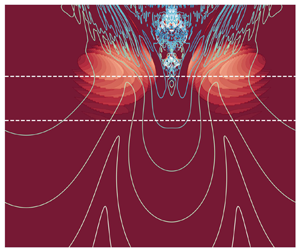Refine listing
Actions for selected content:
1417116 results in Open Access
Distinguished Member Award
-
- Journal:
- Clays and Clay Minerals / Volume 34 / Issue 1 / February 1986
- Published online by Cambridge University Press:
- 02 April 2024, pp. 111-112
-
- Article
-
- You have access
- Export citation
A Model of Clay Swelling and Tactoid Formation
-
- Journal:
- Clays and Clay Minerals / Volume 30 / Issue 5 / October 1982
- Published online by Cambridge University Press:
- 02 April 2024, pp. 383-390
-
- Article
- Export citation
Weathering Sequence and Alteration Products in the Genesis of the Graskop Manganese Residua, Republic of South Africa
-
- Journal:
- Clays and Clay Minerals / Volume 36 / Issue 5 / October 1988
- Published online by Cambridge University Press:
- 02 April 2024, pp. 448-454
-
- Article
- Export citation
Cacoxenite in Miocene Sediments of the Maryland Coastal Plain
-
- Journal:
- Clays and Clay Minerals / Volume 36 / Issue 5 / October 1988
- Published online by Cambridge University Press:
- 02 April 2024, pp. 419-424
-
- Article
- Export citation
Effects of Solution Chemistry on the Hydrothermal Synthesis of Kaolinite
-
- Journal:
- Clays and Clay Minerals / Volume 39 / Issue 5 / October 1991
- Published online by Cambridge University Press:
- 02 April 2024, pp. 498-508
-
- Article
- Export citation
Problems in Identification of Montmorillonite and Beidellite
-
- Journal:
- Clays and Clay Minerals / Volume 35 / Issue 3 / June 1987
- Published online by Cambridge University Press:
- 02 April 2024, pp. 232-236
-
- Article
- Export citation
Nahon Peter, Les parlers français des israélites du Midi. Strasbourg : Éditions de Linguistique et de Philologie (ELiPhi), 2023, 480 p., ISBN : 978 2 372 76066 9.
-
- Journal:
- Journal of French Language Studies / Volume 34 / Issue 3 / November 2024
- Published online by Cambridge University Press:
- 02 April 2024, pp. 522-523
-
- Article
- Export citation
Textural Variation and Composition of Bentonite Derived from Basaltic Ash
-
- Journal:
- Clays and Clay Minerals / Volume 34 / Issue 3 / June 1986
- Published online by Cambridge University Press:
- 02 April 2024, pp. 257-265
-
- Article
- Export citation
Evidence for the Formation of Interlayer Polyacrylonitrile in Kaolinite
-
- Journal:
- Clays and Clay Minerals / Volume 36 / Issue 4 / August 1988
- Published online by Cambridge University Press:
- 02 April 2024, pp. 343-348
-
- Article
- Export citation
Transformation of Trace Element-Substituted Maghemite to Hematite
-
- Journal:
- Clays and Clay Minerals / Volume 36 / Issue 1 / February 1988
- Published online by Cambridge University Press:
- 02 April 2024, pp. 31-38
-
- Article
- Export citation
Regularly Interstratified Chlorite/Vermiculite in Soils Over Meta-Igneous Mafic Rocks in Maryland
-
- Journal:
- Clays and Clay Minerals / Volume 30 / Issue 2 / April 1982
- Published online by Cambridge University Press:
- 02 April 2024, pp. 156-158
-
- Article
- Export citation
Effect of the Dielectric Constant on the Double Layer on Clays
-
- Journal:
- Clays and Clay Minerals / Volume 33 / Issue 4 / August 1985
- Published online by Cambridge University Press:
- 02 April 2024, pp. 329-332
-
- Article
- Export citation
Long-wave instabilities of sloping stratified exchange flows
-
- Journal:
- Journal of Fluid Mechanics / Volume 983 / 25 March 2024
- Published online by Cambridge University Press:
- 02 April 2024, A12
-
- Article
-
- You have access
- Open access
- HTML
- Export citation
Referees-Volume 31
-
- Journal:
- Clays and Clay Minerals / Volume 31 / Issue 6 / December 1983
- Published online by Cambridge University Press:
- 02 April 2024, p. 450
-
- Article
- Export citation
Seventh International Zeolite Conference: Keio Plaza Hotel-Tokyo, Japan August 17–22, 1986
-
- Journal:
- Clays and Clay Minerals / Volume 33 / Issue 6 / December 1985
- Published online by Cambridge University Press:
- 02 April 2024, p. 567
-
- Article
-
- You have access
- Export citation
Kaolinization of Bauxite: A Study in the Vlasenica Bauxite Area, Yugoslavia. I. Alteration of Matrix
-
- Journal:
- Clays and Clay Minerals / Volume 33 / Issue 6 / December 1985
- Published online by Cambridge University Press:
- 02 April 2024, pp. 517-524
-
- Article
- Export citation
Interstratified Clays as Fundamental Particles: A Reply
-
- Journal:
- Clays and Clay Minerals / Volume 33 / Issue 6 / December 1985
- Published online by Cambridge University Press:
- 02 April 2024, p. 560
-
- Article
- Export citation
Iron Sites in Nontronite and the Effect of Interlayer Cations from Mössbauer Spectra
-
- Journal:
- Clays and Clay Minerals / Volume 33 / Issue 1 / February 1985
- Published online by Cambridge University Press:
- 02 April 2024, pp. 21-30
-
- Article
- Export citation
Stacking Faults in Kaolin-Group Minerals in the Light of Real Structural Features
-
- Journal:
- Clays and Clay Minerals / Volume 37 / Issue 4 / August 1989
- Published online by Cambridge University Press:
- 02 April 2024, pp. 297-307
-
- Article
- Export citation
Sediment Diagenesis, edited by A. Parker and B. W. Sellwood. D. Reidel Publishing Company, Dordrecht, Holland, 1983. 427 pages, Hardbound, $53.50. ISBN 90-277-1677-3
-
- Journal:
- Clays and Clay Minerals / Volume 32 / Issue 6 / December 1984
- Published online by Cambridge University Press:
- 02 April 2024, pp. 486-487
-
- Article
- Export citation



